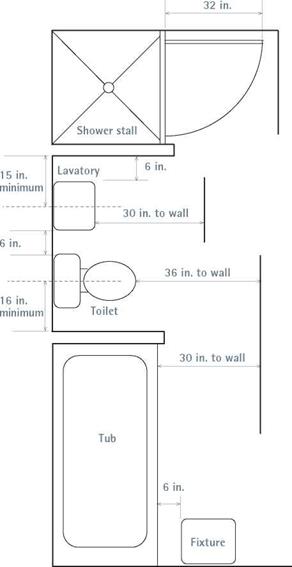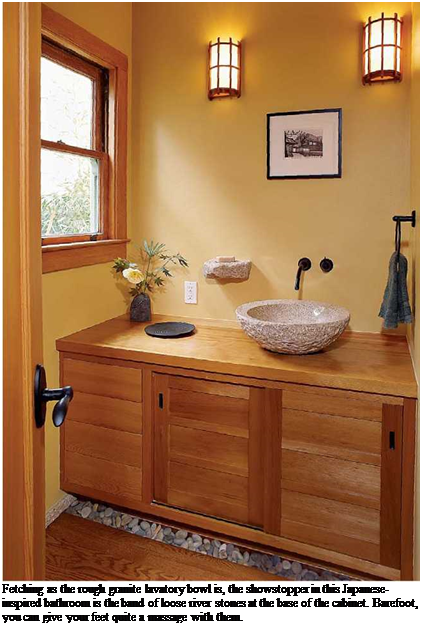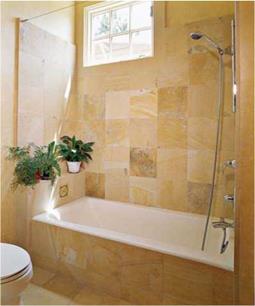CREATING BATHROOMS THAT WORK


Here are 12 factors that help make a bathroom comfortable, functional, and easier to clean:
► Enough room to use fixtures. Bathroom space isn’t efficient if there’s not enough room to use the fixtures easily and safely. "Bath Fixture Clearances," on p. 324, shows mini – mums, which may be superseded by local building codes.
► Keep it secure and intimate. Although shared bathrooms should be accessible to the rooms they serve, bathroom users should feel secure once inside. Avoid multiple-door accesses. Keep the room’s scale intimate as well: Warm, cozy spaces are best.
► Put private fixtures far from the door.
The most-used and least private fixture, the lavatory, should be nearest the door, so people can pop in and wash their hands quickly. But toilets and tubs should be farther away. Insulate walls and install a tight-fitting door to suppress bathroom sounds. Cast-iron waste pipes are quieter than plastic ones.
► Alcoves and half-walls. Placing fixtures in alcoves and odd spaces around the perimeter of a room maximizes the floor space in the middle. Isolating toilets or tubs with
|
|
The tile on the tub surround and floors is Solnhofen limestone, which was formed 150 million years ago in the Mesozoic Era, when warm seas covered present-day Germany. Close up, you can see fossilized sea snails in the stone.


 their own doors also makes it possible to share a bathroom during morning rush hours, yet still have privacy.
their own doors also makes it possible to share a bathroom during morning rush hours, yet still have privacy.
► Natural light. Windows and skylights allow rooms to be small without causing claustrophobia. To block the view of neighbors, install translucent or textured glass, or place windows high on the wall. Windows in showers are generally not a good idea because water sits on windowsills and rots them. Ideally, skylights should open.
► Adequate artificial light. For general lighting, plan on 3 watts to 4 watts of incandescent or 1.5 watts to 2 watts of fluorescent lighting per square foot. For fixtures in alcoves, use a 75-watt or 100-watt recessed, vapor-proof ceiling fixture. To illuminate bathroom mirrors, however, install light fixtures on the walls: one over the mirror and one on each side. Ceiling fixtures alone will make that face in the mirror look ghoulish.
► Comfortable fixtures. "Standard Cabinet Dimensions," on p. 301, suggests counter heights. If they are too high or low for your family, change them so you don’t need to stoop or stand on tiptoes. As for tubs, if you can’t stretch out in a standard tub or squared tub as you’d like, look into oversize models or slope – back, cast-iron clawfoot tubs in a salvage yard. Shower stalls should be big enough to towel off in—36 in. by 36 in.
► Handsome hardware. Buy well-made shower valves, showerheads, and lavatory faucets with nickel – or chrome-plated finishes. They cost two or three times what bargain home-center accessories do, but they’ll last. The same goes for towel bars, switch plates, mirrors, and other accessories—buy quality.
► Use appropriate materials. Water reigns in a bathroom, so use materials that can withstand it. Resilient flooring and tile are great on bathroom floors; wood isn’t. Even when wood is face sealed with a tough modern finish, its end grain can absorb water. And in time, standing water will cloud most finishes. As explained in "Setting Beds," on pp. 383-384, don’t use drywall as a substrate for tile around tubs and showers.
► Ventilate, ventilate. Even if there’s a window in the bathroom, be sure there’s an exhaust fan in the ceiling near the shower.
If it’s a light/fan combo, the fan switch should have an integral timer so the fan can keep running after the light is turned off. See "Controlling Moisture and Mold," on p. 332, for the whole story.
► GFCI protection. All electrical outlets, including fans, must be protected by ground fault circuit interrupters (GFCIs). Shocks could be fatal in such a moist environment, so the National Electrical Code requires GFCI protection on all bathroom and many kitchen outlets. See Chapter 11 for more information.
► Easy-to-clean details. Countertops with integral bowls are much easier to keep clean because there’s no seam for crud to collect in. For the same reason, undermount sinks are
 preferable to sink rims or mounting clips that sit atop the counter. Nonporous baseboards or backsplashes allow you to swab comers with a mop or sponge without worrying about dousing walls or wood trim. Finally, you can mop bathroom floors in a flash if you have wall-hung toilets.
preferable to sink rims or mounting clips that sit atop the counter. Nonporous baseboards or backsplashes allow you to swab comers with a mop or sponge without worrying about dousing walls or wood trim. Finally, you can mop bathroom floors in a flash if you have wall-hung toilets.







Leave a reply